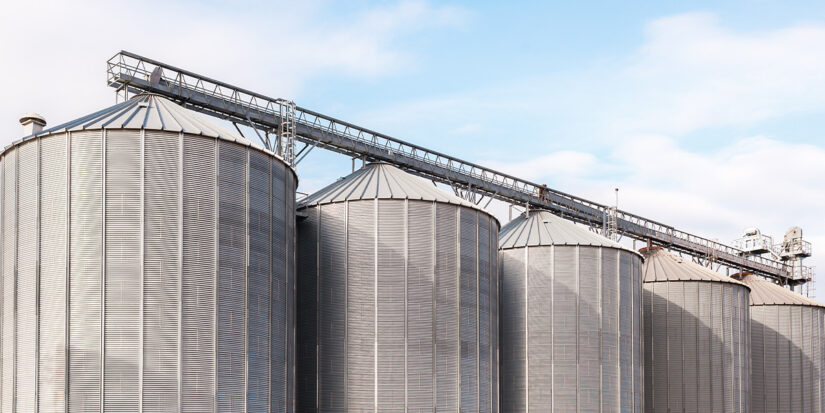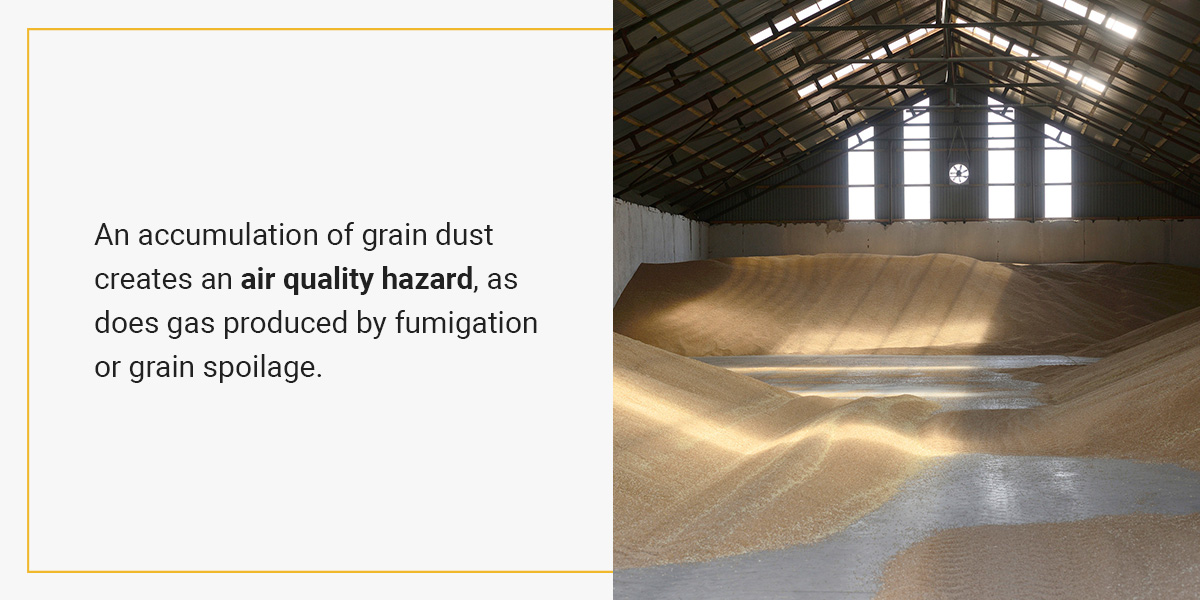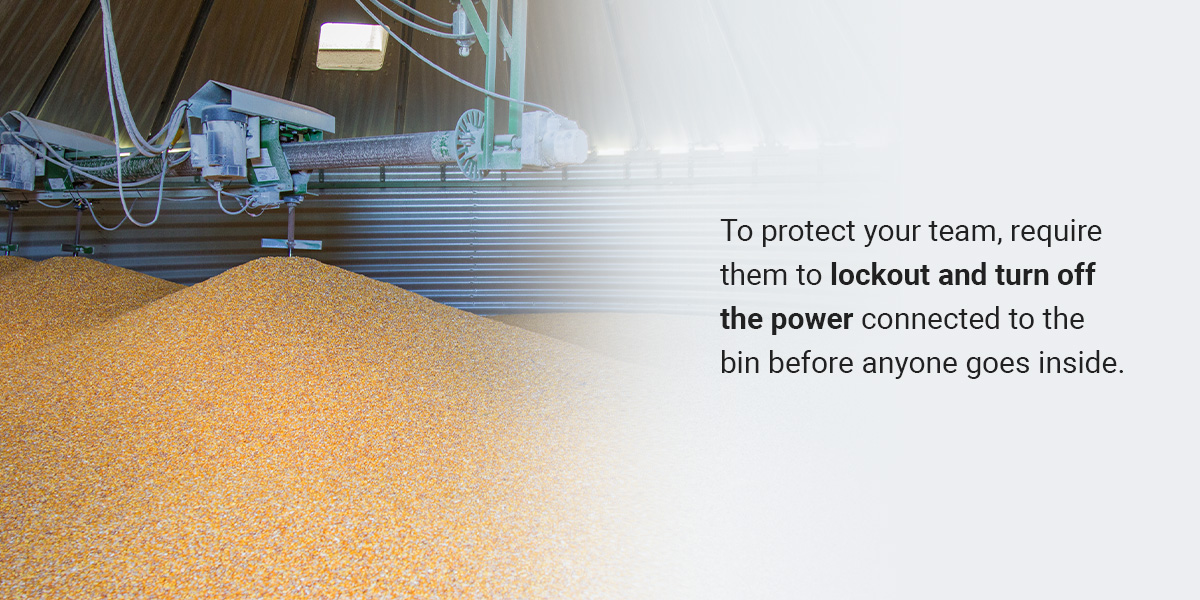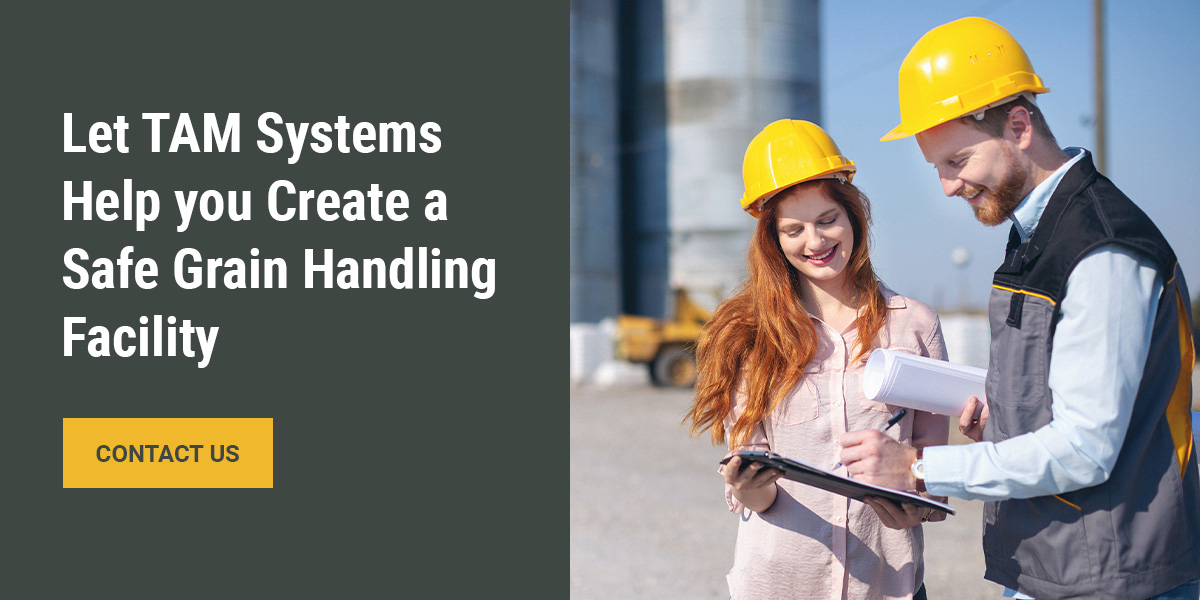Grain is a valuable commodity that provides nourishment for livestock and humans alike. If you operate a facility that harvests or stores grains, you want to do everything to protect the product and keep your employees safe.
Whether your grain handling facility processes and stores barley, wheat, corn or another type of grain, you can take several steps to implement grain handling safety standards. Knowing the type of hazards at your facility is the first step toward keeping everyone safe.
Learn more about safe grain handling and what you need to protect your business, your grains and your team members.
Grain Handling Hazards
Grain handling equipment includes grain bins, grain elevators, hopper bins, elevators and grain dryers. Each piece of equipment has a specific role in the preparation and storage of grains. They also have some particular hazards connected to them. Grain handling hazards include fire, suffocation, falls and bodily harm.
Grain Bin Hazards
The most significant hazard in a grain bin or silo is suffocation. It’s the leading cause of death in grain bins. If a worker walks on grain or tries to move grain built up inside the bin, shifting grains can bury them. When moving, grain can be like quicksand. It can pull a person underneath in seconds, and it’s challenging to get out without assistance.
Grain handling equipment inside the bin, such as augers, can also present a hazard to workers. If someone gets caught in a moving piece of equipment, they can be severely injured or need an amputation. When climbing in and out of a grain bin, there’s a risk that a worker will fall, either from the ladder, the roof or the entrance of the silo.
Grain Dust Hazards
Grain dust is combustible. It can catch fire or explode if it’s airborne and contact an ignition source, such as an overheated motor or hot bearings. An accumulation of dust on a surface also creates a fire or explosion risk. Grain dust explosions or fires are most likely to occur in grain elevators.
Safety standards from the Occupational Safety and Health Administration (OSHA) state that any ignition sources and dust accumulation need to be controlled to minimize the risk of explosions.
Air Quality Hazards
An accumulation of grain dust creates an air quality hazard, as does gas produced by fumigation or grain spoilage. If the grain in a silo goes bad and starts to grow mold or ferment, the workers who handle it can be exposed to contaminants, such as mold spores or toxic gases. Prolonged exposure to mold or gas can lead to respiratory issues.
Pests can be a problem in a grain storage bin. To control pests, you might fumigate the bin. The chemicals used in fumigation also affect the air quality inside the bin, especially if they aren’t used correctly. Exposure to these fumigants can cause lung problems, including cancer, heart disease and nervous system damage. More immediately, a worker exposed to chemical fumigants might pass out, fall into the grain and become engulfed.
Grain Bin Safety Checklist
Fortunately, there are several grain bin or silo safety procedures you can put into place to protect your workers. Many of these checklist items are required by OSHA to keep employees safe on the job and minimize injuries.
1. Always Have a Spotter
Use the buddy system to keep workers safe when they’re going into a grain bin or handling equipment. Every time an employee enters the grain bin, a second employee should act as the observer or spotter. The spotter should remain outside the bin. Their sole role is to keep tabs on the worker in the bin.
In addition to using the buddy system, create rules regarding where workers can go. Since built-up grain products can slide down and engulf workers, make sure everyone knows to avoid areas of buildup and steer clear of bridging conditions.
2. Maintain Equipment
When grain handling equipment overheats, it creates a hazardous environment for workers. The too-hot equipment can cause a fire or explosion if it contacts dust. To minimize the risk of overheating, develop and stick to a preventive maintenance schedule.
It’s also a good idea to use heat-sensitive materials or another method of detecting heat in equipment. If temperatures rise too high, the system can power down, reducing fire or explosion risk.
If your grain handling facility has electrical equipment, make sure it’s designed for use in a hazardous setting. Also, set up a routine maintenance system for electrical wiring to keep it in good operating condition and reduce fire risk.
3. Turn Off the Power
Moving grain can be particularly hazardous, as it can bury workers in just a few seconds. To protect your team, require them to lockout and turn off the power connected to the bin before anyone goes inside. If an auger switches on while a person is in the silo, the grain can begin to empty or move, taking the worker with it.
4. Check the Air First
Before anyone goes into a grain bin, perform an air test. The test should determine if there’s enough oxygen in the bin to breathe comfortably. It should also detect toxic or combustible gases.
If low oxygen levels or hazardous gases are detected, have a process to vent the grain bin. Proper ventilation adds oxygen to the air while washing away dangerous gases.
5. Provide Personal Protective Equipment
Keep your team members safe by giving them the gear to protect themselves anytime they enter a grain bin or handle grain equipment.
If workers climb into the bin, they should have a personal fall arrest system (PFAS), including a body harness, lifeline and anchorage. The PFAS will keep them from falling into the grain and cushion the blow should they slip. In addition to a PFAS, workers should have access to ear protection and respirators to protect their airways.
Creating a safe grain handling environment is a team effort. Work with your employees and ensure they understand the importance of safety before using the equipment or getting access to the grain bins.
TAM Systems Can Help You Create a Safe Grain Handling Facility
A safe grain handling facility is a profitable grain handling facility. The right equipment helps ensure your workers are safe on the job, works longer and needs less maintenance and repair. TAM Systems engineers and designs a variety of durable grain bin models and grain handling equipment. We also offer custom solutions and understand that safety is a priority.
If you’re ready to protect worker safety and preserve grain quality, contact us today for a quote.





